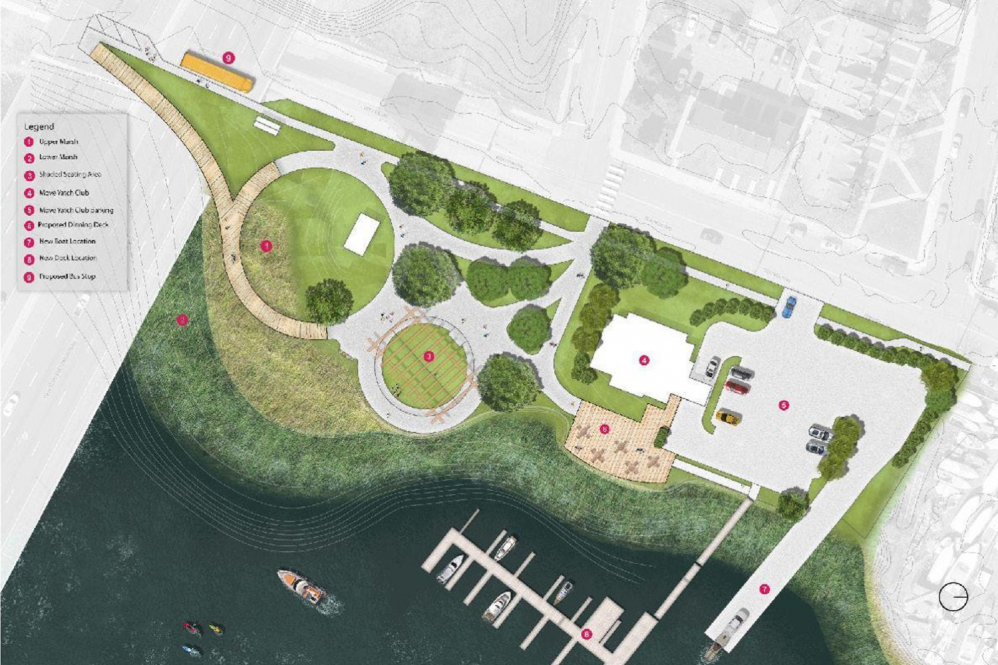Bridgeport sits at the mouth of the Pequonnock River on Long Island Sound, providing it with the longest waterfront in the state.
However, due to historical and ongoing under-resourcing, 70% of the waterfront is currently inaccessible. This has perpetuated racial and socioeconomic disparities that affect access to the ecosystem and public services in Connecticut.
Researchers, students, and alumni from the College of Agriculture, Health and Natural Resources (CAHNR) are working to create and implement plans that would make waterfront areas accessible for Bridgeport residents. The faculty leads on this effort are Jill Desimini, director and associate professor of landscape architecture, and Sohyun Park, associate professor of landscape architecture.
This work aims to make two key portions of Bridgeport’s waterfront accessible. The first is the area known as the “sliver by the river,” in downtown Bridgeport by the train station, and the second is along Yellow Mill Channel, on the east side of the city.
“The impact on the community will be huge,” Park says. “In the past, they did not have access to the waterfront, and now we are opening the access points and revitalizing some vacant land and public spaces to be more resilient and socially functioning.”
As part of their landscape architecture studio, undergraduate students were divided into groups to generate proposals for the areas which have served as the basis for actual work on these sites.
“It was a really exciting project to get to be a part of,” Kayla Villareal ’25 (CAHNR) says. “Being able to see the evolution and implementation of past suggestions was extremely motivating and served as inspiration to the work produced by my cohort. The best part about the work we completed was seeing the impacts it could have in various communities in Connecticut, as well as other states in the future.”
The goal is to not only create a continuous path of access to the waterfront, but to provide community services along the pathway as well. Some amenities included in the plan are kayak launches, benches, parks, and areas for fishing.
The marshlands on the north side of the “sliver by the river” also have the potential to offer important ecosystem services such as improving water quality, erosion control, habitat, and flood abatement once restored.
On the Yellow Mill side, the group has introduced native plants, pollinator gardens, parking, and increased accessibility to the existing waterfront park there. They have also proposed various site activation and place-making strategies, like art walk, painted asphalt, underpass gallery, pop-up skate park, educational signage, guerilla gardening, and more.
“Their ultimate goal is to provide continuous access along the waterfront to the residents of Bridgeport, both to improve the ecological health of the waterfront and the human health of the residents,” Desimini says.
Park says she hopes this work helps inspire community members to continue pushing to improve their neighborhoods.
“You actually spur community engagement further if they see some color on the pavement,” Park says. “I hope the small things we do can have some snowball effect and engage more people in their neighborhood.”
The nationally accredited landscape architecture program at UConn has a longstanding relationship with groups including Groundwork Bridgeport, Trust for Public Land, National Park Service, and the Connecticut chapter of the American Society of Landscape Architects, all of which have been partners for this effort.
Within these organizations and beyond, many CAHNR alumni have been involved in the effort.
“It’s an honor to be involved in such a transformative and beautiful project right in the city I grew up in,” says Ely-Anna Becerril ’21, landscape designer at William Kenny Associates, LLC. [My colleague] Tom Tavella and the students of the Landscape Architecture program provided the fantastic initial ideas and saw the potential for this space to be something special. I’m excited to help push this project forward to becoming a reality for the Bridgeport community to enjoy.”
This project is funded by the City of Bridgeport and various grants from the National Park Service, National Fish and Wildlife Foundation, Long Island Sound Futures Fund, and the National Coastal Resiliency Fund.
This work relates to CAHNR’s Strategic Vision area focused on Promoting Diversity, Equity, Inclusion, and Justice
Follow UConn CAHNR on social media



